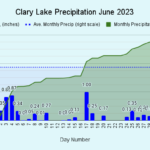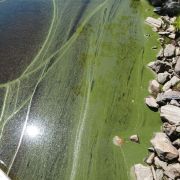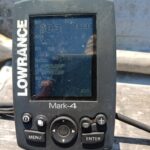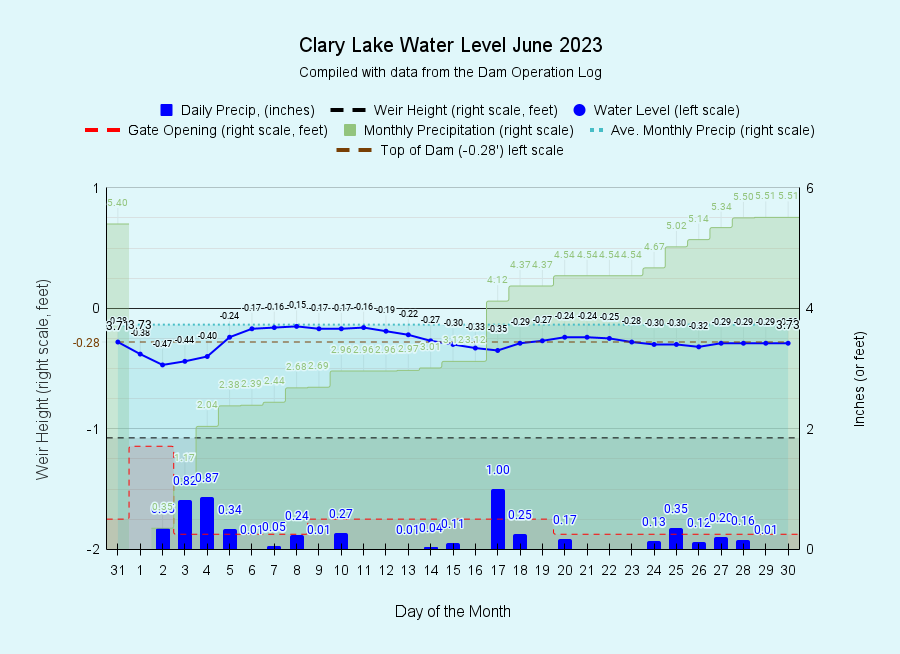I have archived the June 2023 water level chart (at left). If there is one thing that stands out about June 2023 is it was a wet month! We received some amount of rain on 21 of the 30 days of the month making this June the wettest June since 2019.
All told we received a total of 5.51 inches of rain in June, 1.77 inches more than the 3.73 inches which is normal for June. Despite February and March being well below average precipitation, at the end of June we’re fully 5.51 inches of rainfall ABOVE NORMAL for this date. Yes it’s been wet this year! Unlike April and May which both had rather large rain events, most of the rain events in June were small, averaging only 0.28″ per event. It’s like we were dribbled on for the whole month. Despite the almost constant rain, the lake level  remained remarkably stable. With only slight adjustments of the outflows we were able to maintain the lake within a very narrow 3.8 inch range for the whole month, more or less centered around the top of the dam. We started the month at -0.28 feet (top of the dam) and ended the month at the same level. You’ll find ALL the relevant charts (water level, rainfall, flows, etc.) on our Current Clary Lake Water Level Charts page.
remained remarkably stable. With only slight adjustments of the outflows we were able to maintain the lake within a very narrow 3.8 inch range for the whole month, more or less centered around the top of the dam. We started the month at -0.28 feet (top of the dam) and ended the month at the same level. You’ll find ALL the relevant charts (water level, rainfall, flows, etc.) on our Current Clary Lake Water Level Charts page.
 June started out with a short but intense die off of blue-green algae (picture at left), the growth of which was fed primarily by sediment-born Phosphorus introduced into the lake during the intense two-day rain event that took place on April 30th and May 1st. We received a total of 5 inches of rain in those 2 days resulting in the highest lake level we’ve ever recorded, and washed out driveways and roads all over the State. Untold tons of sediment washed into Clary Lake as a result of that one storm. One month later around the first of June, the cyanobacteria that had multiplied with the influx of food started to die and float to the surface where it was corralled by wind and currents along the south and west shore of Clary Lake. It is likely people on the northeast and east shore of the lake never noticed a thing. I collected a sample and dropped it off at the lab at DEP in Augusta. The sample was predominated by Dolichospermum flos-aquae, formerly Anabaena flos-aquae, a blue-green or cyanobacteria species. There was a lot of pine pollen in the sample as well. As the month progressed, the water column cleared considerably with secchi disk reading of 3.87 meters (12.7 feet) on June 23rd.
June started out with a short but intense die off of blue-green algae (picture at left), the growth of which was fed primarily by sediment-born Phosphorus introduced into the lake during the intense two-day rain event that took place on April 30th and May 1st. We received a total of 5 inches of rain in those 2 days resulting in the highest lake level we’ve ever recorded, and washed out driveways and roads all over the State. Untold tons of sediment washed into Clary Lake as a result of that one storm. One month later around the first of June, the cyanobacteria that had multiplied with the influx of food started to die and float to the surface where it was corralled by wind and currents along the south and west shore of Clary Lake. It is likely people on the northeast and east shore of the lake never noticed a thing. I collected a sample and dropped it off at the lab at DEP in Augusta. The sample was predominated by Dolichospermum flos-aquae, formerly Anabaena flos-aquae, a blue-green or cyanobacteria species. There was a lot of pine pollen in the sample as well. As the month progressed, the water column cleared considerably with secchi disk reading of 3.87 meters (12.7 feet) on June 23rd.
 Kelsie French and I got an early start to our 2023 water quality monitoring season in late April with a trip out to the deep hole (picture at left) but the next time out erratic behavior with our YSI Pro 20 Dissolved Oxygen meter prevented data collection. It took some time, but by process of elimination we were finally able to determine that the cable on our 14 year old meter had failed. We ordered a new one for $380 + $10 shipping. They said it would be 7 weeks for delivery but it arrived after only 5 weeks. The new cable solved our problem and we were able resume data collection on June 11th. We’ll be out there every 2 weeks until mid-October. If you see us out there on a Friday afternoon in my red boat, anchored in the middle of the lake, stop by and say hello!
Kelsie French and I got an early start to our 2023 water quality monitoring season in late April with a trip out to the deep hole (picture at left) but the next time out erratic behavior with our YSI Pro 20 Dissolved Oxygen meter prevented data collection. It took some time, but by process of elimination we were finally able to determine that the cable on our 14 year old meter had failed. We ordered a new one for $380 + $10 shipping. They said it would be 7 weeks for delivery but it arrived after only 5 weeks. The new cable solved our problem and we were able resume data collection on June 11th. We’ll be out there every 2 weeks until mid-October. If you see us out there on a Friday afternoon in my red boat, anchored in the middle of the lake, stop by and say hello!

